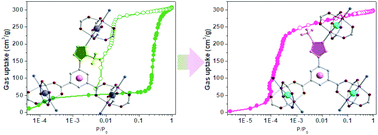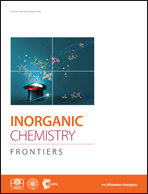Controlled flexibility of porous coordination polymers by shifting the position of the –CH3 group around coordination sites and their highly efficient gas separation†
Abstract
As an emerging class of crystalline materials, porous coordination polymers (PCPs) with regular and flexible nanopores have become particularly promising for adsorption applications. Here, we report a new method to synthesize PCPs with varied flexibility by shifting the position of the methyl group, the shortest alkyl chain, around the coordination sites of T-shaped ligands of H2NL1 (5-(2′-methyl-imidazol-1-yl)-isophthalic acid) and H2NL2 (5-(4′-methyl- imidazol-1-yl)-isophthalic acid). The two generated PCPs (NTU-40 and NTU-41) showed a significant change in gate opening pressure (P/P0: 0.25 to 0.0001) under the stimulus of N2 at 77 K. In addition, the square window (5 × 5 Å2) of the one-dimensional (1D) zigzag channel was divided into two small triangular and straight channels in NTU-41. More importantly, the synergistic effect of structural flexibility, channel type and the micro-pores enabled highly efficient CO2/CH4 and C2H4/CH4 separation under both equilibrium state and dynamic conditions, as well as having good potential for challenging C2H4/C2H6 separation.

- This article is part of the themed collection: Inorganic Chemistry Frontiers HOT articles for 2018


 Please wait while we load your content...
Please wait while we load your content...